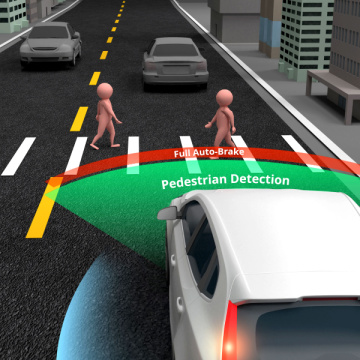Importance of Pedestrian Detection for Industrial Vehicles
In industrial settings, the safety of personnel, as well as equipment, depends significantly on situational awareness of the industrial vehicles. It is true that pedestrians and other obstacles within line-of-sight can be detected by human drivers and onboard sensors. However, in complex workplace environments, obscure dynamic objects often enter the path of a vehicle in an unpredictable manner. This is where pedestrian detection for industrial vehicles comes in.
Pedestrian detection technology is now considered to be one of the most effective ways to reduce workplace accidents involving pedestrians. Essentially an advanced driver assistance system (ADAS), pedestrian detection systems make use of cameras, sensors, as well as artificial intelligence for the identification of pedestrians in the vicinity of industrial vehicles. These systems analyse the surrounding environment for recognizing human forms and movements, which helps mitigate or prevent potential collisions between industry workers and vehicles.
How do they Work?
To detect and track pedestrians effectively, pedestrian detection systems combine a number of advanced technological innovations. Working in unison, these technologies build a comprehensive safety solution for the vehicles.
The most important component of pedestrian detection systems are high-resolution cameras positioned strategically around the vehicle. Visual information related to the surrounding area, including pedestrian movement, sidewalks, crosswalks, gets captured by these cameras. By real-time analysis of captured images, they can identify human forms and movements and distinguish pedestrians from other objects.
Another critical component of these systems is the radar sensor. Utilising radio waves, these sensors can detect all objects present within a specific range. Even in challenging circumstances such as adverse weather or poor visibility, these systems can detect pedestrians because of their ability to measure distance and speed accurately.
Modern-day pedestrian detection often involves the incorporation of Lidar technology. Using laser beams, these systems create a detailed 3D map of the vehicle’s surrounding environment. As a result, pedestrians can be tracked and detected, regardless of lighting conditions. Differentiation of pedestrians from their surroundings is possible because these systems can construct comprehensive spatial representations.
Many experts believe that the real power of these systems lies in their advanced algorithms, hardware, and use of artificial intelligence. Intelligent pedestrian detection systems are capable of analysing data collected from radar, cameras, and Lidar. Processing of this information helps identify pedestrians accurately and differentiate them from different other objects present on the road. Moreover, the most advanced pedestrian systems can predict the behaviour of pedestrians, anticipate potentially hazardous situations, and warn the drivers in a timely manner. As a result of their multi-sensor approach, these systems are extremely accurate and promptly react to potentially collision prone situations.
Benefits of Pedestrian Detection Systems
- Whenever there is a risk of collision, these systems alert the driver by actively monitoring the surroundings. This prior warning helps drivers avoid the collision by taking immediate corrective measures.
- In circumstances where a collision is unavoidable, the impact can be mitigated by using pedestrian detection systems. The severity of collisions can be reduced significantly by activating pre-crash safety measures.
- These systems can minimise driver distraction by enhancing situational awareness, helping prevent workplace accidents resulting from blind spots and driver inattention.
If you want to find out more about pedestrian detection systems, please get in touch with us at ShockWatch.


